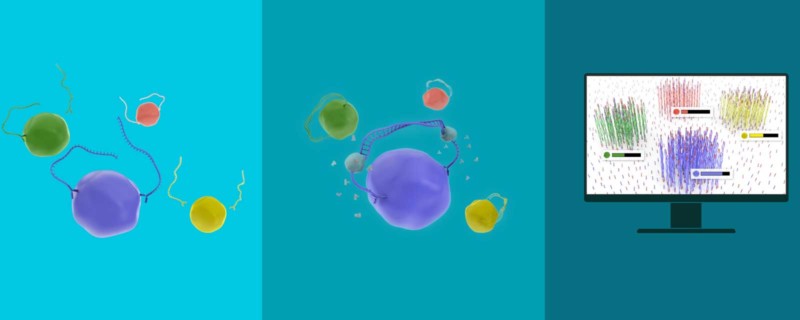
Next Generation Proteomics is the Missing Piece in Completing the Precision Medicine Puzzle
Twenty years ago, the International Human Genome Sequencing Consortium constructed a map of the human genome and with it came the opportunity to look at medicine in new way. The idea of precision medicine, an approach to medicine where an individual’s genes, environment, and lifestyle is considered in disease treatment selection, was enabled for the first time and with it the hope for targeted therapeutics.
In spite of this significant advancement, we still primarily employ a one-size-fits-all therapeutic approach to medicine today. Unfortunately this approach does not yield the kind of results that precision medicine aspires to. Why have we not been able to fully employ precision medicine? Many believe that this is due in large part to the inability to harness proteomics as the missing piece of the precision medicine puzzle.
Importance of Proteomics
When looking at disease and therapeutics, it is critical to look at proteins since they drive the machinery of the human body. Proteins are often the cause of disease (Alzheimer’s for example) and proteins are also frequently administered as a treatment, as demonstrated by the growing used of therapeutic antibodies. In contrast to DNA, which is mostly static throughout life, proteins are dynamic. They offer a real time window into a patient’s health and disease state and allow researchers to study real-time human biology.
Next Generation Proteomics
Protein biomarker discovery can bridge the gap between genomics and phenotypes, thereby providing the kind of data that could profoundly improve future healthcare. What has hampered these efforts has not been a lack of understanding that proteomics is a key piece, but rather the lack of technology to be able to deliver reliable specificity, high throughput, good precision, and high sensitivity.
I was fortunate to be able to interview, Mr. Jon Heimer, President and CEO, Olink about the company’s proteomics technology. He provided an overview of the technology, how it is being used in drug discovery and how it is being employed in the clinic today.
Proximity Extension Assay Technology
Olink Proteomics knew that they needed to provide proteomics that could be coupled with the latest genomics technology to complete this puzzle. To do this they focused on their proximity extension assay (PEA) technology. PEA technology solves many of the limitations of traditional proteomics, enabling the study of many proteins simultaneously with single plex quality, high specificity, and sensitivity. It also covers a broad dynamic range, with minimal sample volume required and perhaps most importantly, the studies are run in high throughput at low cost.
PEA technology combines an antibody-based immunoassay with a digital readout using either quantitative real-time PCR (qPCR) or Next Generation Sequencing (NGS). The unique attributes of this technology support a scalable, multiplex, and highly specific approach where the concentration of more than a thousand protein biomarkers can be quantified simultaneously. PEA is a dual-recognition immunoassay, where two matched antibodies labeled with unique DNA oligonucleotides simultaneously bind to a target protein in solution. This brings the two antibodies into proximity, allowing their DNA oligonucleotides to hybridize, which serves as a template for a DNA polymerase-dependent extension step. The resulting double-stranded DNA “barcode” is unique to each specific antigen and quantitatively proportional to the initial concentration of the target protein. Hybridization and extension are immediately followed by PCR amplification. This provides a highly scalable technique with exceptional specificity. Because the PEA assay requires less than one drop of blood to measure the protein profile in a patient sample, there is no need to worry about applications where the volume of available samples is very restricted.
Low Abundant Plasma Proteome
There is also increasing interest in tapping into the information held within the low abundant plasma proteome. Most proteins show a large variation in abundance between individuals. Some proteins are at such minute concentrations that they are barely detectable. It is this low abundant plasma proteome, however, where the richest store of knowledge related to dynamic biological changes in health and disease may be found. Olink Explore 1536 is well suited to investigate proteins found in the low abundant plasma proteome by providing a substantial increase in throughput and detection for a significantly expanded protein library in a cost-efficient way.
Olink Explore 1536
The Olink® Explore 1536 platform couples PEA with Next Generation Sequencing (NGS) to enable the readout of 1536 assays in 96 samples simultaneously using just 3 µL of sample. It is perfect for studies involving large numbers of human serum or plasma samples where high throughput technology is required. The 1536 assays are arranged into four 384-plex panels that run in parallel, generating over 130,000 data points in less than 36 hours and over 1.3 million protein measurements per system per week. It also has a broad dynamic range with assays that span ten logs (fg/mL – mg/mL).
Scalability
Olink’s PEA technology can achieve a high level of multiplexing while maintaining exceptional data quality. Unlike many other immunoassay formats, Olink’s panels are designed such that no antibody cross-reactivity occurs during the multiplexed assay. Olink spans small to large scale studies, without the need to change platforms, providing a smooth transition between large-scale screening studies and validation of the specific protein signatures that have been identified.
Quality and validation
The Olink Proteomics assays are rigorously quality controlled, and the validation data is completely transparent and freely available. For more information on the analytical performance of the Target 96 panels and validation data on sensitivity, dynamic range, specificity, precision, and scalability, please see Transparent Data Validation.
Advanced Proteomics in Practice
Olink wasn’t the only company to see the tremendous value in proximity extension assay technology. Mr. Heimer shared that major pharmaceutical companies and academic clinical institutions globally have adopted this technology to enhance the drug development process.
He went on to explain that the technology is truly unique as it can be used both to cast a broad net, something that is valuable in research as well as to be truly targeted to look for just one biomarker, for instance in a diagnostic application. The same system could be used seamlessly from research, to the clinic and in future diagnostic applications. While the system typically evaluates blood samples, any sample type can be used including tissue lysates and urine samples.
Drug Discovery – A Proteogenomic Approach
An extremely effective method for drug discovery is to take a proteogenomic approach to identify a causal drug target. A proteogenomic approach combines genomic and proteomic data to both find the causal target and predict which subgroup of the patient population will respond to the drug. To identify the correct patient subgroup, surrogate markers can be identified that tell researchers whether patients will respond to the drug and also whether it is safe. Clinical trial success rates can be increased identifying those patients that would respond to the drug being tested and use this as one of the criteria for trial inclusion. By pairing the right drug target with the right patient population you have the highest probability of success and you can avoid treating patients with therapeutics that won’t have a positive outcome.
Proteogenomic Drug Discovery Consortium
Olink is a central technology used by the SCALLOP consortium. SCALLOP is a collaborative framework of academic and industry members for the discovery and follow-up of genetic associations to proteins on the Olink Proteomics platform. They aim to identify novel molecular connections and protein biomarkers that are causal in disease. So far, 25 principal investigators from 20 research institutions have joined the effort, which now comprises summary-level data on SNP to protein level associations from almost 65,000 patients or controls. SCALLOP welcomes new members.
To take the proteogenomic approach one step further, once the causal target and patient population has been identified, then the underlying biology can also be examined. For instance, the body responds to the drug and which pathways are activated, along with a host of other areas for exploration.
Beyond pharmaceuticals, proteogenomics empowers a proactive approach to healthcare. By examining a patient’s blood, you could theoretically identify who is on track to develop disease in the future. This provides patients the opportunity to make lifestyle, diet and other changes that would reduce their risk of developing disease. Diabetes is a great example of how identifying risk early can inform patients to change their lifestyle and prevent them from developing the disease.
Clinical Studies
Covid-19– In one of the largest longitudinal COVID-19 studies to date, Olink and Massachusetts General Hospital (MGH) collaborated to execute one of the first major protein biomarker studies ever done for COVID-19, using the new Olink Explore 1536 platform. The platform allowed close to 1500 proteins to be rapidly analyzed in a cohort of around 400 COVID-19 patients and symptomatic control subjects. The study generated over 1.3 million protein data points along with associated clinical parameters that were shared with the wider scientific community. This data can be used to augment other researchers’ findings and accelerate the development of new therapies as well as a better understanding of the underpinnings of COVID-19.
To learn more, please see How a Next Generation Proteomics Platform is Accelerating the Fight Against COVID-19
Malignant Melanoma – Mr. Heimer shared work that is being done by Massachusetts General Hospital (MGH) using Olink’s proximity extension assay to be predict which patients will respond at baseline to various melanoma therapies using just one drop of blood. The goal would be to test patients to see which therapeutic would provide the best disease response. It is especially critical in a fast growing cancer like melanoma to know as quickly as possible if patients will respond, otherwise patients can wait six months before they know whether they are responding to the standard treatment of a checkpoint inhibitor.
To learn more, please see Plasma Proteomic Expression Correlated With Immunotherapy Response
Cardiovascular – Jon told me about work being done to predict, which patients among those who have already had one cardiovascular event, are at highest risk of having a second event. In this way, patients at the highest risk for a second event can be treated more aggressively to prevent future issues.
These are just a few of the areas in which Olink’s technology is being used. There are currently over 500 publications, which reference the use of their technology. Please see Olink Publications for the full list.
Mr. Heimer closed the interview by saying that the past decade was devoted to DNA and RNA research and that in this decade, proteomics promises to provide the last piece of the puzzle needed to greatly advance therapeutics by getting the right treatment to right group of patients.
For more information, please visit:
https://www.olink.com/multiomics
https://www.olink.com/immunotherapy
Related articles:
Proteogenomic Strategies to accelerate Drug Discovery and Increase Success
How a Next Generation Proteomics Platform is Accelerating the Fight Against COVID-19
About the Interviewee
 Jon Heimer, MBA, President and CEO, Olink
Jon Heimer, MBA, President and CEO, Olink
As President and CEO of Olink Proteomics the vision and goal is to facilitate the understanding of real-time human biology by accelerating proteomics together with the scientific community. Jon is an entrepreneur and has spent the last 25 years in various biotech start-up companies, developing and commercializing medical devices and biotech drugs. He studied economy at the Uppsala University and has an MBA from IHM Business school in Stockholm. Jon was part of a small team that started Swedens latest most successful biotech which grew to 800 people around the world, market leader in its segment, went public and eventually sold to Galderma. Prior to joining Olink Proteomics as President and CEO he ran a small orphan drug company developing two drugs into late stage clinical trials through the FDA with novel treatments for hyperoxaluria.